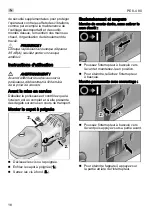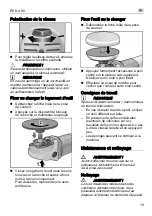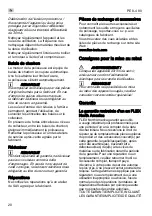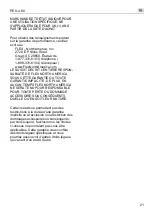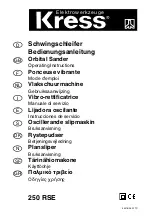
PE 8-4 80
6
Wear personal protective equipment.
Depending on the application, wear full
face protection, eye protection or goggles.
If appropriate, wear a dust mask, hearing
protection, protective gloves and/or
a special apron which protect you from
small material particles. You should protect
your eyes from foreign objects which are
ejected for different applications. Dust and
respirator masks must filter the dust which
is generated by the power tool for the
particular application. If you are exposed to
loud noise for a prolonged period, you may
suffer hearing loss.
Ensure that other persons are situated
at a safe distance from the work area.
Anyone who enters the work area must
wear personal protective equipment.
Fragments of the workpiece or broken
insertion tools may fly off and cause injuries
even outside the direct working area.
If the insertion tool is at risk of coming into
contact with concealed power cables or the
power cord itself, hold the power tool by the
insulated grip surfaces only. Contact with a
live cable may also cause metal parts of
the appliance to become live and result in
an electric shock.
Keep the power cord away from rotating
insertion tools. If you lose control of the
appliance, the power cord could be
severed or become caught and your hand
or arm may strike the rotating insertion tool.
Never put down the electric power tool until
the insertion tool has come to a standstill.
The rotating insertion tool may come into
contact with the support surface, possibly
resulting in you losing control of the electric
power tool.
Never leave the electric power tool running
while you are carrying it. Your clothing may
become caught by accidental contact with
the rotating insertion tool which may then
drill into your body.
Regularly clean the ventilation slots on
your electric power tool. The motor fan
draws dust into the housing; a large build-
up of metal dust may cause electrical
hazards.
Never use the electric power tool near
combustible materials. Sparks may ignite
these materials.
Never use insertion tools which require
liquid coolants. The use of water or other
liquid coolants may result in electric shock.
Do not allow any loose parts of the
polishing hood, in particular fixing cords.
Stow or shorten the fixing cords. Loose,
entrained fixing cords may trap your fingers
or become entangled in the workpiece.
Some dust created by power sanding,
sawing, grinding, drilling and other
construction activities contains chemicals
known to the State of California to cause
cancer, birth defects or other reproductive
harm. Some examples of these chemicals
are:
– Lead from lead-based paints.
– Crystalline silica from bricks, cement,
and other masonry products.
– Arsenic and chromium from chemically-
treated lumber.
Your risk from these exposures varies,
depending upon how often you do this type
of work. To reduce your exposure to these
chemicals:
– Work in a well-ventilated area.
– Work with approved safety equipment,
such as dust masks that are specially
designed to filter out microscopic
particles.
– Avoid prolonged contact with dust from
power sanding, sawing, grinding,
drilling, and other construction activities.
Wear protective clothing and wash
exposed areas with soap and water.
Allowing dust to get into your mouth or
eyes or to lie on the skin may promote
absorption of harmful chemicals.
Recoil and appropriate safety
instructions
Recoil is the sudden reaction caused by
a rotating insertion tool which sticks or is
blocked. A rotating insertion tool which
sticks or is blocked stops abruptly. As a
result, an uncontrolled electric power tool is
accelerated against the direction of rotation
of the insertion tool at the blocking point.
A recoil occurs if the electric power tool is
used incorrectly or improperly. A recoil can


















